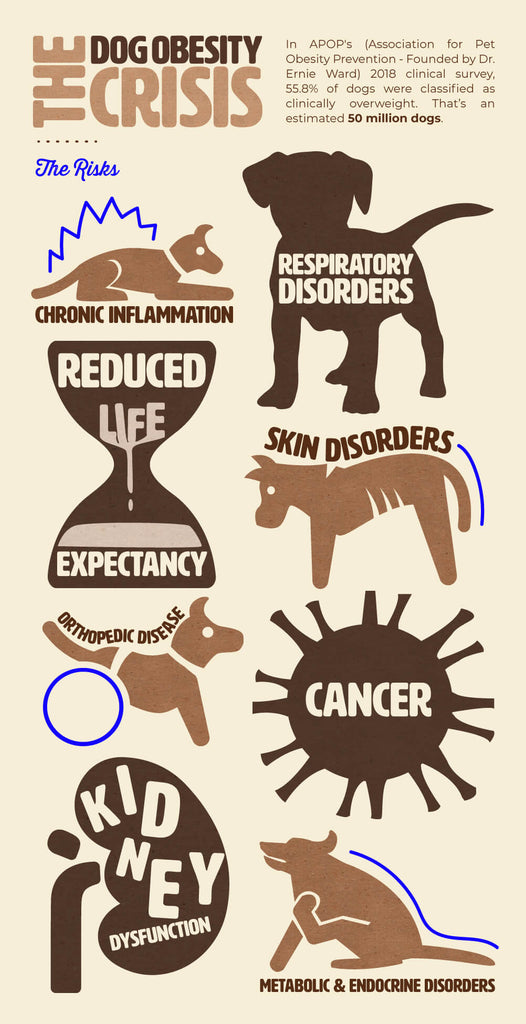
The Vet's Corner: The Risks of Pet Obesity
This is part 1 in Wild Earth’s 3 part series on pet obesity. Pet obesity is an epidemic that is severely hurting the quality of life of the pets we love. Part 1 is on the risks of pet obesity, part 2 covers how to determine if your pet is overweight and part 3 details a weight loss strategy.
Obesity is our pets’ number one health threat. That’s why I’ve spent most of the last 20 years researching and advocating for increased awareness and better treatment options for dogs and cats suffering from obesity.
I founded the Association for Pet Obesity Prevention (APOP) in 2005 with a simple goal: To help future generations of pets enjoy longer, happier, and healthier lives. Today’s dogs and cats are living longer than ever before, largely due to advances in immunizations, parasitic preventives, and nutrition. Unfortunately, this generation of pets is also more likely to have obesity, chronic pain due to weight-related arthritis, and costly obesity-related diseases such as diabetes.
When it comes to preventing disease and helping your pet live a long, healthy, pain-free life, there may be nothing more important than maintaining a healthy weight. Obesity and excess weight in dogs and cats is one of the most commonly diagnosed medical disorders in veterinary practice. In the United States, an estimated 56% of dogs and 60% of cats are classified as overweight or obese, in the United Kingdom 46% of dogs, 34% of cats and 30% rabbits, and global estimates of overweight or obese pets range from 22% to 44% .
How pet obesity, climate change, and animal welfare led to Wild Earth
That’s one of the reasons I co-founded Wild Earth. I knew the past 20 years of veterinary nutritional research supported higher-protein, higher-fiber diets for both healthy weight maintenance and weight loss in dogs and cats. I was also increasingly concerned about the increasing impact pet food production was creating on climate change and promoting animal factory farming.
By working with brilliant food scientists and animal nutritionists, we were able to create the world’s first high-protein, high-fiber plant-based dog food. I also co-wrote a thoroughly researched book on this topic, “The Clean Pet Food Revolution: How Better Pet Food Will Change the World” with our CEO, Ryan Bethencourt, and animal ethicist Alice Oven.
By feeding your dog Wild Earth dog food, you’re providing nutritious, complete-and-balanced, AAFCO-approved dog food while helping make a positive change in the world. Because Wild Earth is specifically formulated to be high in both protein and fiber, feeding it may also help your dog maintain a healthy weight.
In this first part of my series, let’s look at why it’s so important we put an end to pet obesity. Being overweight brings a whole host of health dangers that can likely be avoided.

The Risks of Pet Obesity
Pets suffering from obesity are prone to a vast number of weight-related disorders. If your dog needs to shed a few pounds, consider these serious consequences of obesity as you’re looking for motivation.
Decreased life expectancy and poor quality of life
Less is more when it comes to feeding pets and living longer. Eating less has been proven to extend life expectancy and reduce suffering in species as diverse as worms, spiders, water fleas, fruit flies, fish, hamsters, mice, rats, dogs, and monkeys. In a 1999 longevity study conducted on dogs, researchers found dogs fed 25% fewer calories than normal lived an average two years longer.
Even more exciting was that the dogs fed a little less food had a lot fewer medical problems, including arthritis and cancer. The study dogs also required fewer prescription medications and remained more active well into “old age.” If you’re looking for the Fountain of Youth for your dog, it may be found in their food bowl.
Arthritis
The number one medical condition associated with excess weight is osteoarthritis (OA). Both large and small breeds of dogs are typically affected but cats are developing crippling arthritis at alarming rates.
A March 2011 study concluded that the majority of cats (61%) had radiographic evidence of OA. Interestingly, few parents recognized the signs of arthritis, leading the study authors to strongly advise radiographs in older cats, especially those demonstrating inappropriate elimination or household “accidents.”
If your pet is carrying as little as one or two extra pounds, keep in mind those pounds are stressing tiny joints not designed to carry the extra weight. Making matters worse, fat cells produce harmful chemicals known as adipocytokines that damage even non-weight bearing joints. There is no cure for osteoarthritis other than surgically replacing the joint; we can only minimize the pain. Preventing excess weight and obesity is key to helping your pet maintain a long, pain-free life.
Diabetes
Veterinarians are increasingly diagnosing diabetes in cats with obesity. Similar to humans, overweight cats are at tremendous risk for developing high blood sugar and diabetes, often requiring twice daily insulin injections.
Dogs with obesity are more prone to a condition known as insulin resistance, a state in which they have dangerously high insulin and blood sugar levels, and may also develop diabetes.
Both diabetes and insulin resistance have been shown to reduce a pet’s life expectancy in addition to requiring constant medication and treatment. Diabetes is largely prevented by simply feeding the amount of food to maintain a normal weight. What could be easier?
High blood pressure
Sometimes we forget our pets get many of the same diseases we do. Hypertension is one of these commonly overlooked conditions in pets. High blood pressure is known as the “silent killer” because you can’t tell if your pet has it nor can you see the damage it’s causing – until it’s too late.
If your dog or cat has packed on a few extra pounds, have its blood pressure checked regularly by your vet. This simple test can help prevent sudden blindness, heart problems, and kidney failure. Early recognition and treatment can be as simple as changing to a low-sodium diet, weight loss, and increasing exercise. Blood pressure medications are needed in more serious cases.
Cancer
Excess fat has been implicated in the formation of many cancers in animals. The National Cancer Institute estimates that obesity and physical inactivity may account for 25% to 30% of the major cancers in humans: colon, breast cancer in postmenopausal women, endometrial, kidney, and cancer of the esophagus.
New research points to obesity-related insulin resistance as a likely cause. While we don’t have as many dog and cat research studies to draw upon, the consensus is that excess weight increases a pet’s risk of developing many types of cancer. Reduce the weight to reduce the risk.
The trouble with our pets being plump isn’t vanity; excess weight causes or worsens many serious medical conditions in dogs and cats. Our animal companions depend on us to make good choices for them. Make sure you’re feeding your pet based on sound nutritional advice and not due to clever marketing or price.
The Risks are Real
We want to do what is best for our pets and the most beneficial thing we can do is manage their weight in a healthy way. Obesity is the number one health threat pets face, and the most important pet health decision pet parents make each day is what and how much they feed. In the next article, we’ll look at how you can assess your pet's weight and whether they may have an issue.




























